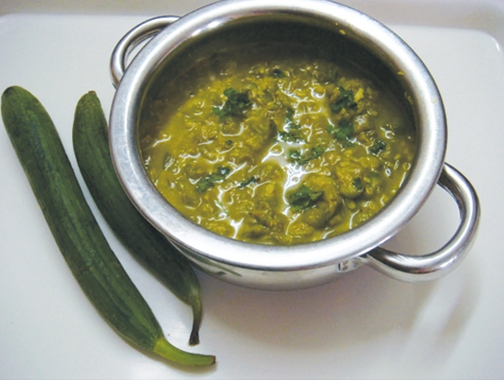Mama’s Punjabi Recipes:Tori te Wadiyan (Zucchini Squash & Dumplings)
In North India, the gourd or squash that is really widely available and used is the tauri, the short, thin and dark green variety that is commonly called zucchini in the US. The most used is the long, smooth and stout, leaf green squash which resembles a bottle, called ghia or kadoo and known as the bottle gourd in the US.
Tauriyan are so easy to grow in a small strip of land as it is a vine that can be trained to climb up on strings. In our three-story home in Rajouri Garden in West Delhi, we had tauriyan growing every year and the slender green cylinders hung over the outer white brick wall and many people would pick them as they walked by!
Tauriyan are also very low in calories, contain no saturated fats or cholesterol and the peel is good fiber that reduces constipation and gives some protection from colon cancers. They are also high in potassium and contain moderate levels of B-complex vitamins.
Most Punjabis won’t enjoy eating tauriyan by itself as they are limp when cooked and taste watery. Wadiyan are just the ingredient to enhance the flavor of the dish as the small pieces mix with the cooked tauriyan. The spiciness and aroma of the wadiyan permeate through the dish and add that special zest when you bite into a piece along with the tauri.
Apart from the ingredients, the secret to good wadiyan is the hot sunshine of the Punjab’ as these lentil dumplings have to dry on their own and not force-dried through an oven. Usually, wadiyan are made of channe (chickpeas) or hare channe (green chickpeas) and the black mahn or urad daal: some people, like my mother, would even leave a few small hara channe in each dumpling for added flavor.
Just as with ghia, tauriyan cook fast in its own vapor in a kadai (wok); and you have to be careful just that the dish doesn’t get too mushy. There is no need to add piyaaz (onions), adrak (ginger) or lasan (garlic) to this dish either as the wadiyan bring out the taste.
Ingredients:
8 medium tauri (zucchini squash) – choose ones tender in the middle
1 or 2 Punjabi wadiyan (lentil dumplings) – spiciness to taste
2 tbsp tael (olive oil or vegetable oil)
½ tsp haldi (turmeric powder)
5.Spices to taste: namak (salt), mirch (red pepper), garam masala
Directions:
1. Cut off the top stalk, don’t peel the tauri, but cut into 1/2 inch thick wedges. Wash thoroughly and let them drip dry in a strainer.
2. Heat the oil in a kadai over medium heat. Break the wadiyan into ½ inch pieces, throw in and stir till they are slightly brown. Add ½ cup of water and cover over low heat for 5 minutes so that the wadiyan become soft. Add the haldi, namak, mirch and stir.
3. Now add the cut tauriyan, stir till they are coated. Cover and let it cook in its own steam for 10 minutes over medium heat.
4. Take the cover off and check if the tauriyan have let off enough vapor and are tender. If the water is low, turn off heat and cover; if not then let it cook uncovered for 10 more minutes over low heat till the water is reduced. Stir gently to make sure it doesn’t stick.
5. For best taste, sprinkle with garam masala and serve with hot rotis or crispy paranthas.
MAMA’S TIP OF THE WEEK
MAKE FLUFFIER OMELETS WHILE COOKING
When there is nothing else at home, eggs are an easy solution for a quick meal. In New Delhi, especially on cold winter days, hawkers make a brisk trade making omelets or serving hot boiled eggs to customers on the go. Recently, researchers have reported that eggs, including the yolk, may not increase your cholesterol as has been thought.
In any case, Indians love their omelets, especially when made with all the spices and mix of cut vegetables. The trick to making them light and fluffier is to allow air to mix in while the egg is being beaten. Since most people simply beat the mixture with a fork a few times, continuing to turn the omelet while it is cooking will help add more air and make it fluffier.
Shakuntla Malhotra is a skilled cook of Punjabi dishes made in the old-fashioned style that she learnt as a young woman in her ancestral home in Lyallpur, India before it became part of Pakistan after the Partition in 1947. People have often admired her cooking for its simplicity and taste that comes with each mouthful. Even in her mid-eighties, she continues to cook daily and agreed to share some of her delectable Punjabi recipes.


